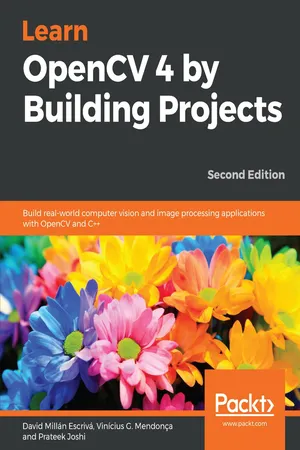
Learn OpenCV 4 by Building Projects
Build real-world computer vision and image processing applications with OpenCV and C++, 2nd Edition
- 310 pages
- English
- ePUB (mobile friendly)
- Available on iOS & Android
Learn OpenCV 4 by Building Projects
Build real-world computer vision and image processing applications with OpenCV and C++, 2nd Edition
About This Book
Explore OpenCV 4 to create visually appealing cross-platform computer vision applications
Key Features
- Understand basic OpenCV 4 concepts and algorithms
- Grasp advanced OpenCV techniques such as 3D reconstruction, machine learning, and artificial neural networks
- Work with Tesseract OCR, an open-source library to recognize text in images
Book Description
OpenCV is one of the best open source libraries available, and can help you focus on constructing complete projects on image processing, motion detection, and image segmentation. Whether you're completely new to computer vision, or have a basic understanding of its concepts, Learn OpenCV 4 by Building Projects – Second edition will be your guide to understanding OpenCV concepts and algorithms through real-world examples and projects.
You'll begin with the installation of OpenCV and the basics of image processing. Then, you'll cover user interfaces and get deeper into image processing. As you progress through the book, you'll learn complex computer vision algorithms and explore machine learning and face detection. The book then guides you in creating optical flow video analysis and background subtraction in complex scenes. In the concluding chapters, you'll also learn about text segmentation and recognition and understand the basics of the new and improved deep learning module.
By the end of this book, you'll be familiar with the basics of Open CV, such as matrix operations, filters, and histograms, and you'll have mastered commonly used computer vision techniques to build OpenCV projects from scratch.
What you will learn
- Install OpenCV 4 on your operating system
- Create CMake scripts to compile your C++ application
- Understand basic image matrix formats and filters
- Explore segmentation and feature extraction techniques
- Remove backgrounds from static scenes to identify moving objects for surveillance
- Employ various techniques to track objects in a live video
- Work with new OpenCV functions for text detection and recognition with Tesseract
- Get acquainted with important deep learning tools for image classification
Who this book is for
If you are a software developer with a basic understanding of computer vision and image processing and want to develop interesting computer vision applications with OpenCV, Learn OpenCV 4 by Building Projects for you. Prior knowledge of C++ will help you understand the concepts covered in this book.
Frequently asked questions
Information
An Introduction to the Basics of OpenCV
- Configuring projects with CMake
- Reading/writing images from/to disk
- Reading videos and accessing camera devices
- The main image structures (for example, matrices)
- Other important and basic structures (for example, vectors and scalars)
- An introduction to basic matrix operations
- File storage operations with XML/YAML persistence OpenCV API
Technical requirements
Check out the following video to see the Code in Action:
http://bit.ly/2QxhNBa
Basic CMake configuration file
cmake_minimum_required (VERSION 3.0) project (CMakeTest) add_executable(${PROJECT_NAME} main.cpp) Creating a library
# Create our hello library add_library(Hello hello.cpp hello.h) # Create our application that uses our new library add_executable(executable main.cpp) # Link our executable with the new library target_link_libraries(executable Hello)
Managing dependencies
cmake_minimum_required (VERSION 3.0) PROJECT(Chapter2) # Requires OpenCV FIND_PACKAGE( OpenCV 4.0.0 REQUIRED ) # Show a message with the opencv version detected MESSAGE("OpenCV version : ${OpenCV_VERSION}")
# Add the paths to the include directories/to the header files include_directories(${OpenCV_INCLUDE_DIRS})
# Add the paths to the compiled libraries/objects link_directories(${OpenCV_LIB_DIR}) # Create a variable called SRC SET(SRC main.cpp) # Create our executable ADD_EXECUTABLE(${PROJECT_NAME} ${SRC}) # Link our library TARGET_LINK_LIBRARIES(${PROJECT_NAME} ${OpenCV_LIBS}) cmake_minimum_required (VERSION 3.0) cmake_policy(SET CMP0012 NEW) PROJECT(Chapter2)
# Requires OpenCV FIND_PACKAGE( OpenCV 4.0.0 REQUIRED ) # Show a message with the opencv version detected MESSAGE("OpenCV version : ${OpenCV_VERSION}") include_directories(${OpenCV_INCLUDE_DIRS}) link_directories(${OpenCV_LIB_DIR}) Table of contents
- Title Page
- Copyright and Credits
- About Packt
- Contributors
- Preface
- Getting Started with OpenCV
- An Introduction to the Basics of OpenCV
- Learning Graphical User Interfaces
- Delving into Histogram and Filters
- Automated Optical Inspection, Object Segmentation, and Detection
- Learning Object Classification
- Detecting Face Parts and Overlaying Masks
- Video Surveillance, Background Modeling, and Morphological Operations
- Learning Object Tracking
- Developing Segmentation Algorithms for Text Recognition
- Text Recognition with Tesseract
- Deep Learning with OpenCV
- Other Books You May Enjoy